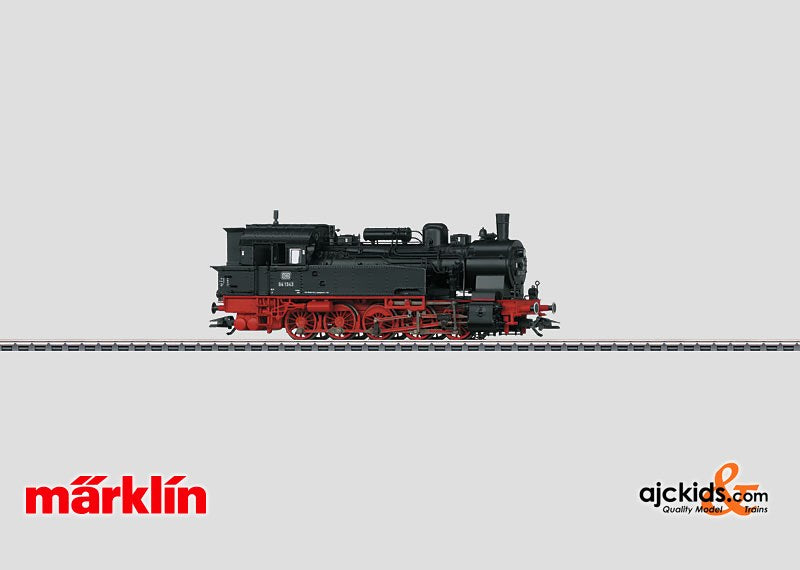Marklin 37160 - Freight Locomotive with a Tender BR 94.5 (Sound)
Gauge: H0 Era: III
Prototype: German Federal Railroad (DB) class 94.5-18 freight tank locomotive, with bell and pre-warmer on the top of the boiler, radio antenna for switching, and buffer plate warning stripe. Road number 94 1343. The locomotive looks as it did around 1960.
Model: The locomotive has an mfx digital decoder and extensive sound functions. It has controlled high-efficiency propulsion with a bell-shaped armature and a flywheel, mounted in the boiler. 5 axles powered. Traction tires. The locomotive is constructed mostly of metal. A 72270 smoke generator can be installed in the locomotive. The triple headlights change over with the direction of travel. They and the smoke generator contact will work in conventional operation and can be controlled digitally. The headlights are maintenance-free warm white LEDs. Protective piston rod sleeves brake hoses are included.
Length over the buffers 14.6 cm / 5-3/4".
Highlights:
- Completely new tooling.
- Locomotive constructed mostly of metal.
- Especially fine design with many separately applied details.
- High-efficiency propulsion with a bell-shaped armature, mounted in the boiler.
- A variety of operating and sound functions that can be controlled.
The famous Prussian locomotive department head Robert Garbe initiated the development of a five axle tank locomotive in 1904, whose frame and running gear was to be designed using the Gölsdorf Principle for better running on curves. The first, third, and fifth driving axles were mounted with side play and the drive was on the fourth driving axle. The firm Berliner Maschinenbau AG (BMAG, formerly Schwartzkopff) delivered two prototypes based on this principle as early as 1905. Additional units of the new class T 16 quickly went into service. Due to partially dissatisfactory running characteristics the drive was switched from the fourth to the third driving axle starting in 1910, the latter driving axle now being mounted rigidly. In 1913 systematic changes were made with the installation of a four-part super heater, valve gear with Kuhn slides instead of hanger valve gear as well as exhaust steam pre-heater that was initially mounted lengthwise and later next to the boiler. The transfer to the T 16.1 was complete with this "reinforced" T 16. Purchases of this T 16.1 stretched out to 1924, i.e. well into the period of the DRG. A total of 1,236 units were built for Prussia and the DRG. In addition to BMAG, Hanomag, Henschel, and Linke-Hofmann also participated in the building of them from 1921 on. In 1915 Grafenstaden delivered another six of the T 16.1 for Alsace-Lorraine. Reparations after the end of World War I decimated the ranks such that the DRG was able to reclassify the remaining T 16.1 locomotives as road numbers 94 502-1380 and 94 1501-1740. The T 16.1 units were not only powerful locomotives for pusher and freight service.
Starting in the Twenties the DRG equipped a number of the T 16.1 locomotives with a Riggenbach counter-pressure brake for operation on steeply graded routes. They were used in part in Thuringia, and in West and South Germany replaced rack railroad operations with rack locomotives there. After the end of World War II a large number of the locomotives found new homes in Poland, Austria, Yugoslavia, Hungary, Czechoslovakia, and the USSR. The majority of the class 94 locomotives remained however in the western zones. After units damaged in the war were retired, the DB in 1950 still had 679 of the T 16.1 on its roster while the DR in East Germany still had 249 of these locomotives after the end of the war.
The class 94 locomotives remained indispensable on both German railroads for decades, chiefly at large switch yards, and many of them were thus equipped with radio switching equipment. In 1968 140 locomotives on the DB were given the computer-generated class designation of 094. It was the stepped up delivery of the class 290/291 heavy diesel switch engines that finally replaced the last of these locomotives with their five driving axles so that in December of 1974 the last of the T 16.1 units were retired. The T 16.1 remained in use on the East German DR only a little bit longer than on the DB. The last units were retired in 1975. At least twelve of the T 16.1 escaped the cutting torch. Road numbers 94 1292 on the Rennsteig Railroad and 94 1538, which has stood for many years as a monument in Gönnern, have the best chances of being put back into operational condition.
Charlie's Tip: This model can be found in a DC version in the Trix H0 assortment under item no. Trix 22159.
| Control Unit | Sx | Mobile Station | DCC | Mobile Station 2 | Central Station | |
| Headlight(s) | · | · | · | · | ||
| Smoke generator contact | · | · | · | · | ||
| Steam locomotive op. sounds | · | · | · | · | ||
| Locomotive whistle | · | · | · | · | ||
| Direct control | · | · | · | · | ||
| Sound of squealing brakes off | · | · | · | |||
| Bell | · | · | · | |||
| Whistle for switching maneuver | · | · | · | |||
| Letting off Steam | · | · | · | |||
| Air Pump | · | · | ||||
| Sound of coal being shoveled | · | · | ||||
| Grate Shaken | · | · | ||||
| Injectors | · | · | ||||
| Generator Sounds | · | · | ||||
| Cab Radio | · | · | ||||
| Sound of Couplers Engaging | · | · |
Released in: New items brochure 2012
EAN/UPC: 4001883371603



